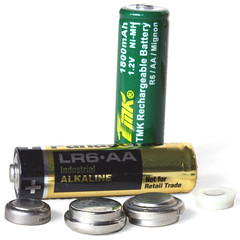Mercury cells
Mercury cells (also referred to as mercury batteries) are batteries with a mercury oxide electrode. Mercury batteries were discovered in the 19th century, and a practical method to make small button batteries was discovered by Ruben and Mallory.[1] These type of battery use the reaction between mercuric oxide and zinc electrodes in an alkaline electrolyte. The biggest advantage of these batteries is that the voltage during discharge remains practically constant at 1.35 volts.
After WWII these batteries were very popular, as they could deliver constant and reliable voltage in a small format (button) they were used for toys, cameras, and even pacemakers and hearing aids. Research carried outin the 1970s proved that ingestion of batteries could cause severe illness in kids, and that the toxicity of Mercury was leaching off landfills into streams. Mercury batteries were banned, except for medical and military use, in most countries. In the 21st century, manufacture, transport or sale of these batteries is banned or restricted nearly worldwide, due to the metal's toxicity; although some are still made in Russia. Alkaline, lithium and other batteries have replaced mercury cells in most applications. However, before such bans, many cameras and lightmeters were designed to use them. Because mercury batteries produced a constant and reliable voltage over the life of the battery (discharge curve), these devices were built without voltage regulation circuitry. Use of other kinds of batteries, that have different discharge curves over time, without regulation circuitry may lead to inaccurate meter readings and therefore incorrect exposures and must be taken into account.
Contents
Cell names and sizes

|
| 386, PX625 (x2), PX400 mercury button cells compared to AA batteries image by AWCam (Image rights) |
Mercury batteries came in number of different sizes including the 32, 400, 625, 640, 675 and the like. Most of the mercury batteries are a single electrolytic cell - usually small and circular. However, the 32 is a set of 4 stacked 640 cells. The greatest number of cameras, finders and light meters were designed for the PX625.
| Common number | Alternative names | Diameter (mm) | Height (mm) | Weight (g) |
|---|---|---|---|---|
| 625 | 1124MP, MR9, PX625, PX13, EPX625, RPX625, KX625, HD625, PN625, RM625, 625, H1560, H-D, MR9 | 15.6 | 6.05 | 4.5 |
| 675 | 1128MP, MR44, PX675, HD675, KX675, RPX675, H-C | 11.6 | 5.35 | 2.6 |
| 400 | 1116M, MR42, E400N, EPX400, KX400, PM400R, PX400, RM400, T400N, V400PX | 11.6 | 3.6 | 1.4 |
| 640 | 1105M, NR52 | 16 | 11.2 | 8 |
| 32 | 1404M, 4NR52, PX32, E164, TR164, 4NR52, 1404M. HM-4N, V164PX, PX32A, PX32B | 17 | 44.5 | 36 |
Devices requiring mercury batteries
Many cameras and lightmeters where designed for and require a 625 mercury cell, PX675 or 400 cells (see a list of cameras and list of exposure meters). Some cameras and exposure meters were designed for 625, 675, or 400 sized cells but include voltage regulation circuitry and thus do not require a Mercury Cell to function properly (list of devices).
Mercury battery replacement
This is a problem that many owners of vintage equipment face.
- Zinc-air batteries used for hearing aids, produce 1.35V and have a similar discharge curve than mercury batteries but their life is short
- Silver oxide or Alkaline batteries, produce 1.55V and might not be suitable for non-voltage regulated equipment
- Adapter circuitry can be bought from several suppliers. Some of the adapters use a Schottky diode to reduce the voltage [2].
External links
- Suggestions from Rick Oleson (based on ideas from Leon Schoenfeld) to make classic cameras give acceptable meter readings using zinc-air hearing aid batteries.
- The mercury cell problem and its solutions (PDF file) by F. de Gruijter. Also discusses PX675 and other mercury batteries. Available from Butkus's orphan camera as well
- The mercury oxide battery problem, at Konica SLR system, providing information about the PX625 and PX675 battery that is not specific to Konica models
- Quirks of using zinc-air hearing aid batteries to replace mercury cells part 1 and part 2 from Silverbased (Archived)
- Energizer Battery Online Data
- Russian mercury px625 battery Seller of PX625 mercury batteries.
Notes
- ↑ Samuel Ruben: Inventor, Scholar, and Benefactor Electrochemical Society Journal Fall 2006
- ↑ The mercury Battery problem by FP De Gruijter page 8-10
References
- Popular Photography, October 1993, p. 130; January 1994, p. 144; September 1994, p. 144; and August 1995, p. 66.
- Hintz, Eric S. 2009. "Portable Power: Inventor Samuel Ruben and the Birth of Duracell" Technology and Culture Vol. 50, No. 1 (Jan., 2009), pp. 24-57 (34 pages). Published By: The Johns Hopkins University Press Available at jstore.org